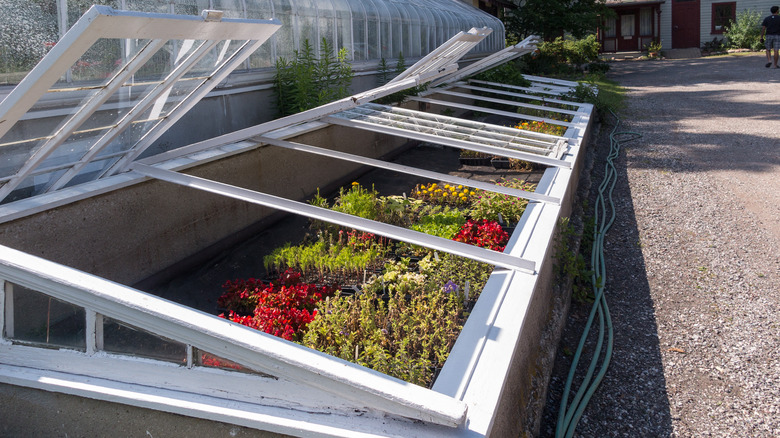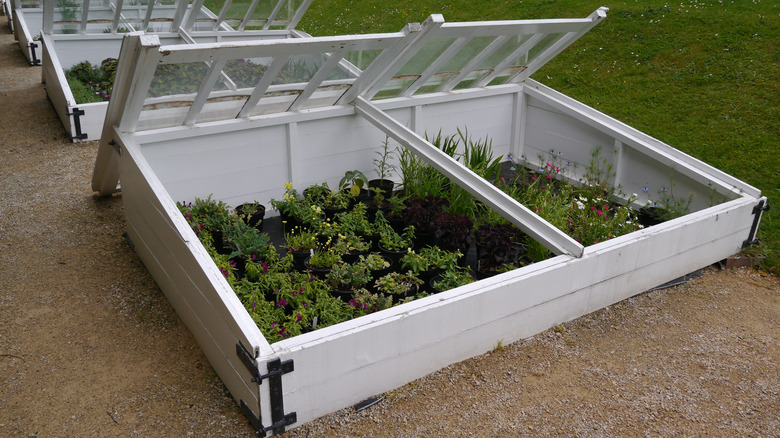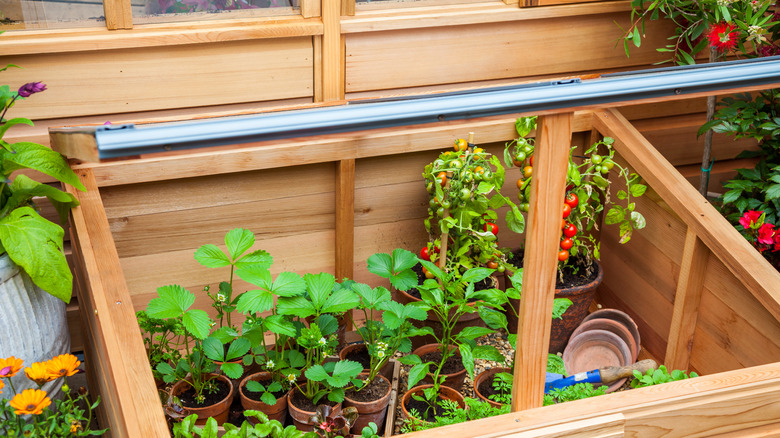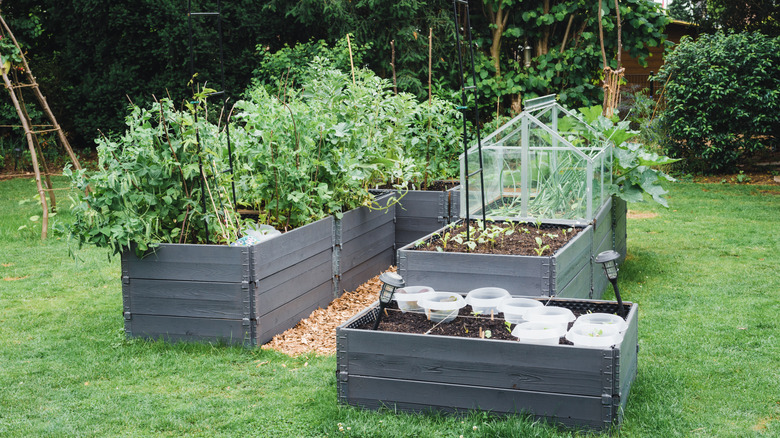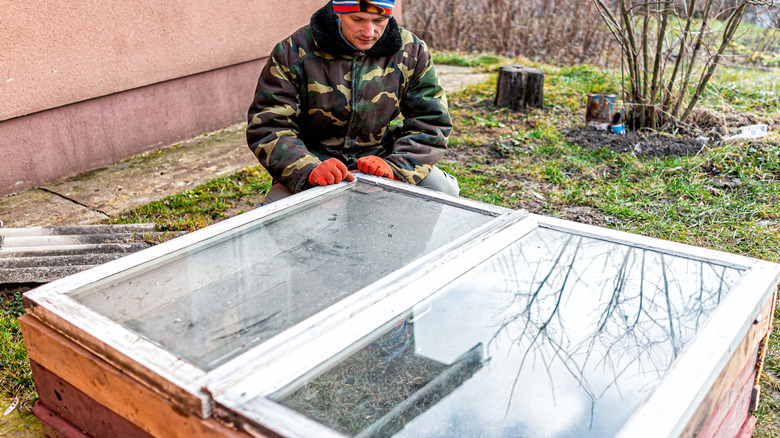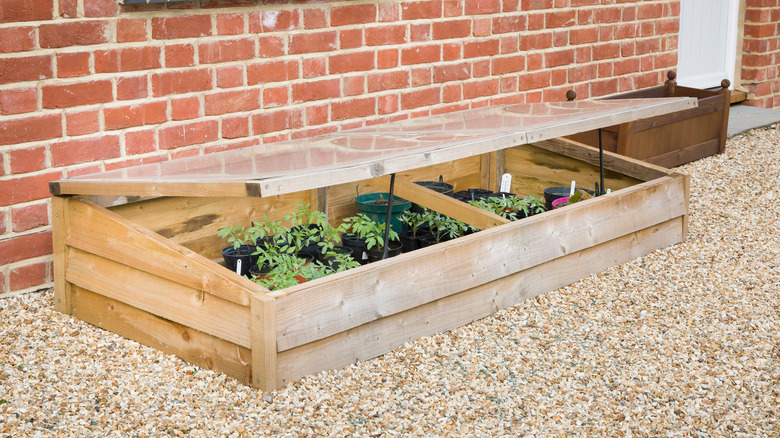What Is Cold Frame Gardening?
If you are an avid gardener, you surely know that putting the seeds in the ground on time is vital. Winter comes with extremely low temperatures and even shorter days, which is not the ideal environment for gardening. While you can begin the seeds indoors, you will quickly realize that plants started indoors in special conditions experience transplanting shock and often don't survive, via the University of Missouri Extension. Sunlight is essential for plant growth, and gardening can become almost impossible during the cold winter.
Since indoor gardening is not an option for most people, your best bet for gardening during these cold months is using a cold frame. This concept might come across as intimidating, but it extends your gardening season into the colder winter months. So if you are new to cold frame gardening, this post is for you. We will explore exactly what cold frame gardening is, evaluate the cost implications of building one, and find out what you can plant in yours. Stick around to find out more!
What is a cold frame?
True to its name, a cold frame is a transparent structure that protects plants from cold temperatures while allowing sunlight to pass through, via the University of Missouri Extension. Usually, the temperature inside the cold frame is only a few degrees warmer than the outside, which often makes all the difference. Cold frames may look different depending on the available materials and overall handyman skills, but the principle remains the same. While cold frames were traditionally used to harden seedlings, they have found multiple uses that have been revolutionary to gardeners over time.
Other uses of cold frames include; extending the growing season of some plants past frost, overwintering plants, and starting cold hardy species way earlier than they can be grown on bare soil. However, there are a couple of things that you have to realize before constructing a cold frame. First, not every plant tolerates cold temperatures; some cannot survive even when protected in a cold frame. Also, the materials you use will determine how much protection the plants will get.
What can you grow in a cold frame?
Contrary to popular belief, cold frames are not exclusive to the cold weather; these mini-structures are helpful throughout the year. Different plants can benefit immensely from a cold frame regardless of the season. You can use the cold frame during the spring to start certain heat-loving vegetables like tomatoes earlier before summer. The warmer microclimate inside the structure allows you to plant the vegetable directly in the soil earlier than you typically would.
You need to realize that a cold frame is not a miracle worker, especially when thinking of gardening during or close to winter. You will have a difficult time keeping alive plants grown for summer during winter, even if they are in a cold frame. To get the best out of your cold frame, consider planting low-growing and cold hardy plants with some tolerance to the cold temperature. An excellent example of some cool season plants includes kale, carrots, beet radishes, and lettuce, just to mention a few, via the University of Missouri Extension.
The best location for a cold frame
The ideal location for a cold frame should be a position in your garden that receives a lot of morning and midday sun. Usually, this should be on the south-facing side of your property, according to the University of Minnesota Extension. Since you will also need to check on your plants frequently, remember to position the cold frame not far away from your home. If this location also gets a lot of snow during winter, you won't shovel much if the cold frame is closer to your house. It is also a good idea to build the cold frame away from trees and any obstacles that may cause damage.
This is particularly true, especially if your transparent material is glass. Another reason for building this structure in an open space away from trees is to avoid shading during the critical few hours when the plants should be getting their daily dose of sunshine. Taking advantage of the cold frame during the cold seasons is often underestimated. Remember, you don't need too big of a space to install a cold frame. All you need is an open space with enough sun exposure, which could be right in your backyard or porch.
Cold frame dimensions
A one size fits all mentality doesn't apply when working with cold frames; you should build one depending on your needs. Usually, the type and number of plants will determine how big and tall your cold frame should be. While the size and height are relative, one design detail that should always be constant is ensuring that the top lid is transparent. Once you have identified the right spot, build your cold frame sloping towards the sun's direction. This is necessary to ensure that the sun's rays get to every plant inside the box.
Also, building the frame with a gentle slope allows snow and rainwater to slide off easily. According to the University of Wisconsin-Madison Division of Extension, the transparent lid should also be hinged. This will enable you to pop open the cold frame for temperature balance on those sunny days that get pretty hot. For beginner gardeners, starting small is always a good idea if it is your first time using a cold frame. A typical 4 feet by 4 feet structure should be enough to get you started as you learn the ropes.
So is it worth having a cold frame?
A cold frame is an essential tool necessary for every garden. The opportunity of having a safe place to harden your seedlings in preparation for transplanting goes a long way in ensuring the seedlings survive. What's more, cold frames also give gardeners the luxury of extending the productivity of perennial plants through the cold winter season. This guarantees a continuous harvest and the production of fresh produce past the growing season.
Fortunately, building a cold frame is a DIY project you can work on from home. However, if you are not entirely confident in your handy skills or don't have the time, you can easily purchase a pre-built option. According to the CostHelper, a regular cold frame costs between $30 and $100, while the larger options go for about $100 to $600. It is also worth mentioning that the cold frame is no silver bullet. There are no guarantees of success if you garden during the off-season, even with a cold frame; however, the silver lining is that failure presents an opportunity to learn.
